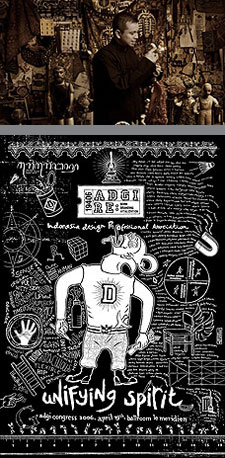YOUR CREATIVE LIFE
Around the World in 10 Interviews: Jakarta, Indonesia
Interview by Carmen Pease
Ever wonder what it’s like to be a designer in Barcelona or Buenos Aires, Kenya or Croatia, Australia or Indonesia? We interviewed creatives in ten countries to see what the state of design is like in their backyards.
To coincide with this year’s April International Design Annual, we decided to pull back the grid of latitude and longitude even further and hear, firsthand, what designers in these different countries have to say about design—how their location impacts their work, how clients embrace their creativity, what’s inspiring them and what kinds of projects keep them busy.
Here, Ignatius Hermawan Tanzil from LeBoYe talks about design in Indonesia’s capital.
LeBoYe
Jakarta, Indonesia
> Where are you located, and why do you enjoy being there?
Indonesia is a large archipelago comprising more than 15,000 islands and spanning three time zones. As a major shipping crossroads in early history, this culturally diverse country is a unique blend of Arabic, Chinese, Malay and European influences, which are still evidenced today in Indonesia’s varied traditions and the diversity of its art forms.
> How would you describe your style?
My design style surely began with my place of birth, its local cultures and traditions, and my humble family background. Second, my formal education at the California College of the Arts was instrumental in helping me focus and refine my personal style.
> What kinds of design does your firm specialize in?
We are an interdisciplinary design firm specializing in creating image and branding identities, corporate communications, corporate brochures, packaging and other marketing collateral. Most of our clients selectively seek us to communicate their ideas in a visually strong and effective manner, with good Feng Shui.
> What’s a favorite project you’ve worked on?
I prefer projects that are developed from the very beginning from nothing, vis-à-vis projects that are half-baked elsewhere. I also have a preference towards book design. Because of the many elements involved, I regard book design much like directing a good play. Much thought has to be given to harmoniously blending the story, rhythm, character and details in one unique package.
> What things influence your work? Where do you get your inspiration?
I am inspired by everything that I experience, learn, read and see. My character, mood and beliefs also influence my work. As a human being from the East, my belief in the power and harmonious alliance of yin and yang has translated well into my works, which are characterized by contrasting colors, shapes and proportions. I often put an unexpected twist, such as a dash of humor, into my design, whenever it is permitted, to make my works more humane and alive.
> How do you think your community and clients view design?
Graphic design in Indonesia (vis-à-vis other, more developed countries) is virtually in its infancy. The creative economy is a relatively new concept in this country, and we are fortunate to be involved in helping the industry grow and improve.
> Do you think there’s anything that sets your location’s design aesthetic apart from other places?
Yes, Indonesia’s rich cultural heritage and tradition inevitably has a strong influence on the local industry’s design aesthetic. An example is evidenced in the traditional batik cloth. Each has its own distinctive design motifs, ornamentations and color combinations. Every intricate detail and design evolves from symbolisms rich in meaning and handed down over the ages, such as in the “Kawung” motif, which is a four-petalled blossom representing Buddhism’s four cardinal directions.
I would hope that every Indonesian graphic designer would also recognize the richness of our heritage and learn to innovatively incorporate it in their respective works. I firmly uphold to the belief that everyone should preserve and protect the uniqueness of their respective cultures. That would be our individual creative contributions against today’s tide of global mass culture and capitalism.
> Is there any cultural proverb or saying that you think influences the way you approach your work?
“Alah (kalah) beli menang memakai.” This is a vernacular version of the universal wisdom of “Making the most of what you’ve got.” Even if one starts out poorly, investing a lot of time and hard work in what you may have available will be eventually rewarded in the end. Another meaning is, to get something with quality, you have to pay the price.
> If you were a color, what color would you be?
Purple. I love purple.
Other interviews in the series
AUTUMN:01: Sydney, Australia
BLOK DESIGN: Mexico City, Mexico
Laboratorium: Zagreb, Croatia
LeBoYe: Jakarta, Indonesia
Steinbranding: Buenos Aires, Argentina
Third World Media: Nairobi, Kenya
Twopoints.net: Barcelona, Spain
weissraum.de(sign): Hamburg, Germany
Yellow Octopus Pte Ltd: Singapore
Zetalab: Milan, Italy
Carmen Pease is HOW’s associate editor. carmen.pease@fwpubs.com.
Source: HOW April 2007
Quoted
Sekolah membuat desainer menjadi pintar, bekerja membuat desainer menjadi paham, pengalaman panjang membuat desainer menjadi arif


